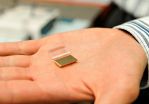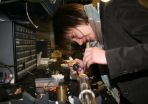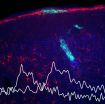Latest bone research abstracts summarized in slides and videos
International Osteoporosis Foundation provides key research findings presented at the 2014 ASBMR meeting in succinct slide set format
2014-10-27
(Press-News.org) Today, the International Osteoporosis Foundation (IOF) has published an educational slide deck highlighting 60 original scientific abstracts presented at the Annual Meeting of the American Society for Bone and Mineral Research (ASBMR) in September 2014.
The succinct slide kit can be downloaded free of charge by all individual IOF members (free sign up on the IOF website).
CEO Judy Stenmark stated, "IOF is pleased to provide this informative resource for healthcare professionals interested in the latest advances in bone and mineral research. While 10% of the featured research highlights exciting new basic research, 90% is clinically focused and therefore of essential interest to a broad range of practitioners and clinical researchers."
The abstracts have been selected and prepared by leading international experts who give their personal perspectives and highlight the clinical impact of the research presented. Key themes include:
Bone architecture and strength
Vitamin D, nutrition and metabolism
Osteoporosis treatment and new treatment strategies
Falls, frailty and fractures
Bone turnover markers
In addition, the following four symposia and plenary sessions are summarized: biochemical markers in the routine management of osteoporosis; International ONJ Task Force – 2014 Consensus on Diagnosis and Management; effects of diabetes on skeletal health; and ASBMR NOF Task Force on goals for osteoporosis treatment.
Video interviews of selected experts are also featured.
Slide sets are available at http://www.iofbonehealth.org/what-we-do/training-and-education/educational-slide-kits/congress-highlights-asbmr-houston-2014
INFORMATION:
If you are not already an IOF member, please sign up to become a free IOF member and to gain access to the slides and other valuable health professional resources: http://www.iofbonehealth.org/become-member
This project was made possible thanks to an unrestricted educational grant provided by Eli Lilly.
ELSE PRESS RELEASES FROM THIS DATE:
2014-10-27
Toronto, Canada – Making mistakes while learning can benefit memory and lead to the correct answer, but only if the guesses are close-but-no-cigar, according to new research findings from Baycrest Health Sciences.
"Making random guesses does not appear to benefit later memory for the right answer , but near-miss guesses act as stepping stones for retrieval of the correct information – and this benefit is seen in younger and older adults," says lead investigator Andrée-Ann Cyr, a graduate student with Baycrest's Rotman Research Institute and the Department ...
2014-10-27
VANCOUVER ─ Different ethnic groups have widely varying differences in both the prevalence and awareness of cardiovascular risk factors, a finding that highlights the need for specially designed education and intervention programs, according to a study presented today at the 2014 Canadian Cardiovascular Congress.
The conclusion comes from a study of more than 3,000 patients at an urgent-care clinic serving an ethnically diverse area of Toronto. Participants were asked to self-identify their ethnicity and, from a list of 20 activities or conditions, asked to identify ...
2014-10-27
VANCOUVER ─ People facing mental health challenges are significantly more likely to have heart disease or stroke, according to a study presented today at the Canadian Cardiovascular Congress.
"This population is at high risk, and it's even greater for people with multiple mental health issues," says Dr. Katie Goldie, lead author of the study and a postdoctoral fellow at the Centre for Addiction and Mental Health in Toronto
Using data from the Canadian Community Health Survey, Dr. Goldie explored the associations between cardiovascular risk and disease, mental ...
2014-10-27
VANCOUVER ─ Heart surgery patients who received newly donated blood have significantly fewer post-operative complications than those who received blood that had been donated more than two weeks before their surgery, a study presented at the Canadian Cardiovascular Congress has shown.
The study examined records at the New Brunswick Heart Centre (NBHC) in Saint John for non-emergency heart surgeries performed over almost nine years, from January 2005 to September 2013, on patients who received red blood cells either during their surgery or afterwards and who stayed ...
2014-10-27
This news release is available in French.
In less than a minute, a miniature device developed at the University of Montreal can measure a patient's blood for methotrexate, a commonly used but potentially toxic cancer drug. Just as accurate and ten times less expensive than equipment currently used in hospitals, this nanoscale device has an optical system that can rapidly gauge the optimal dose of methotrexate a patient needs, while minimizing the drug's adverse effects. The research was led by Jean-François Masson and Joelle Pelletier of the university's Department ...
2014-10-26
In an analysis that included approximately 35,000 participants, genetic predisposition to elevated low-density lipoprotein cholesterol (LDL-C) was associated with aortic valve calcium and narrowing of the aortic valve, findings that support a causal association between LDL-C and aortic valve disease, according to a study appearing in JAMA. The study is being released to coincide with its presentation at the Canadian Cardiovascular Congress.
Aortic valve disease remains the most common form of heart valve disease in Europe and North America and is the most common indication ...
2014-10-26
Stanford, CA— Proteins are the machinery that accomplishes almost every task in every cell in every living organism. The instructions for how to build each protein are written into a cell's DNA. But once the proteins are constructed, they must be shipped off to the proper place to perform their jobs. New work from a team of scientists led by Carnegie's Munevver Aksoy and Arthur Grossman, describes a potentially new pathway for targeting newly manufactured proteins to the correct location. Their work is published by The Plant Cell.
The team's discovery concerns ...
2014-10-26
October 26, 2014, New York, NY – Ludwig Oxford researchers have discovered a key mechanism that governs how cells of the epithelia, the soft lining of inner body cavities, shift between a rigid, highly structured and immobile state and a flexible and motile form. Published in the current issue of Nature Cell Biology, their study shows that a tumor suppressor protein named ASPP2 functions as a molecular switch that controls this process and its reverse, both of which play a critical role in a number of biological phenomena, including wound healing, embryonic development ...
2014-10-26
PROVIDENCE, R.I. [Brown University] — Superconductors and magnetic fields do not usually get along. But a research team led by a Brown University physicist has produced new evidence for an exotic superconducting state, first predicted a half-century ago, that can indeed arise when a superconductor is exposed to a strong magnetic field.
"It took 50 years to show that this phenomenon indeed happens," said Vesna Mitrovic, associate professor of physics at Brown University, who led the work. "We have identified the microscopic nature of this exotic quantum state of ...
2014-10-26
Scientists have created cells with fluorescent dyes that change color in response to specific neurochemicals. By implanting these cells into living mammalian brains, they have shown how neurochemical signaling changes as a food reward drives learning, they report in Nature Methods online October 26.
These cells, called CNiFERs (pronounced "sniffers"), can detect small amounts of a neurotransmitter, either dopamine or norepinephrine, with fine resolution in both location and timing. Dopamine has long been of interest to neuroscientists for its role in learning, reward, ...
LAST 30 PRESS RELEASES:
[Press-News.org] Latest bone research abstracts summarized in slides and videos
International Osteoporosis Foundation provides key research findings presented at the 2014 ASBMR meeting in succinct slide set format


